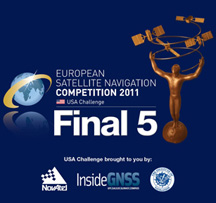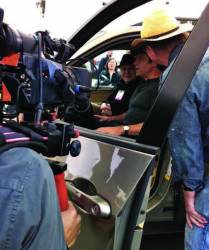
The following was first of five finalists in the 2011 USA Challenge. The North American regional contest in the European Satellite Navigation Competition(ESNC) is part of a global search for the newest, best and most innovative GNSS application ideas. True 3D Volumetric HUD went on to win €20,000 in prize money as the international winner, the 2011 Galileo Master.
The following was first of five finalists in the 2011 USA Challenge. The North American regional contest in the European Satellite Navigation Competition(ESNC) is part of a global search for the newest, best and most innovative GNSS application ideas. True 3D Volumetric HUD went on to win €20,000 in prize money as the international winner, the 2011 Galileo Master.
True3D Volumetric HUD
What is the True3D head-up display (HUD), and how is it different? MVSC is home to inventors and engineer-developers who have mastered the art of miniaturizing 3D, volumetric, conformal display hardware for cars, trucks and all other vessels and craft. Our hardware design offers drivers an exceptionally wide field of view and components that are easily sourced and generally inexpensive.
Why do these qualities matter? While many of us have seen, or own cars with 2-dimensional Head Up Displays, this is not a comparable tool. 2D HUDs in cars today display images “on” our windshields. They can never display images any further ahead than the depth of the windshield itself. Never “out there” in the landscape, as military-grade HUDs are expected to do.
To get “out there,” a Head Up Display must offer images that conform to the true locations of object like road signs by enhancing their actual location with translucent, augmented imagery, hence the term “conformal display.” In studies focused on airport safety, NASA demonstrated that conformal display is always superior to flat, “on the windshield” display when helping pilots get their bearings on the ground. Situational awareness improves only when our navigational cues are out there, in synch with the depth and location of real objects.
MVSC designed our HUD with NASA’s studies firmly in mind. Images are illuminated delicately so as to enhance, never muddy, the driver’s total view through the windshield.
For years, 3D conformal Head Up Display has only been offered in military aircraft. Car-makers and manufacturers of smaller, more ubiquitous aircraft and vessels have been unable to source conformal HUDs at prices their buyers would accept. Moreover, the size of these systems has been prohibitively large. Researchers have attempted to reduce size and component cost, but all have failed thus far to produce a reliable, small hardware package and the capacity to display objects from close-up to the driver, to an “infinity” depth in the landscape.
No HUD developers have done so in a way that offers moving images, constantly refreshing, in a package small, light and inexpensive enough to make its way into all cars eventually. The MVSC True3D Volumetric Head Up Display does all of these things.
The closest that others (Audi/VW, BMW, Bosch, Denso, GM, Light Blue) have come to building a 3D conformal display is placing objects at fixed distances, not moving, about two meters in front of a driver’s eyes, in a hardware package about the size of an under-counter refrigerator.
The world’s foremost automotive display researchers had essentially given up trying to push the size and cost of 3D conformal HUDs down far enough to enter the automotive supply chain. We did not. Chris Grabowski, Tom Zamojdo and Dave Kessler built the elusive small, inexpensive, 3D volumetric HUD.
WHO DID IT?
MVS California LLC
San Francisco, California USA
Juliana Carnes, Chris Grabowski, Tom Zamojdo, Dave Kessler
FOR MORE INFO
www.mvs.net
Learn about the other finalists:


